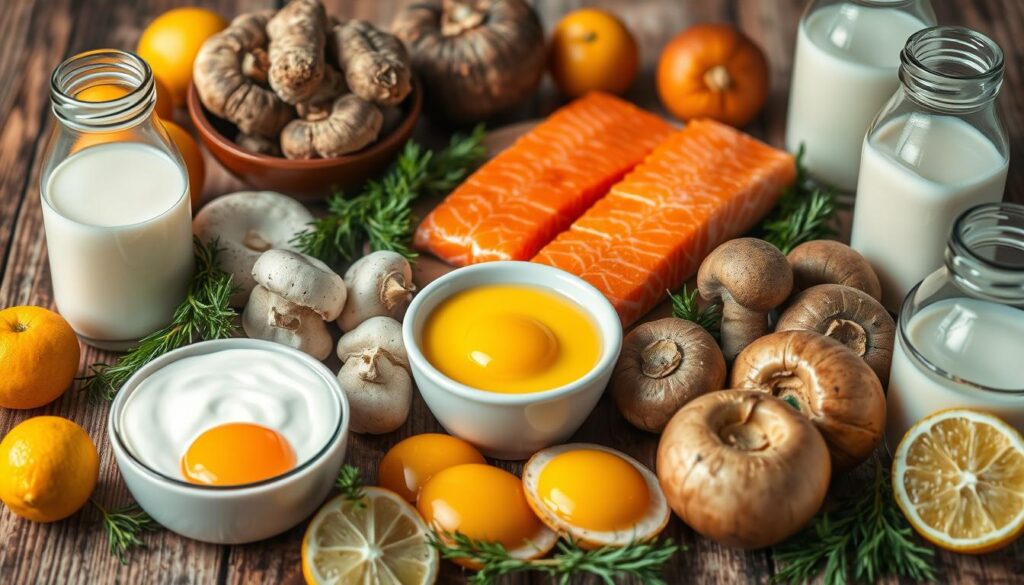Are you getting enough vitamin D? This vital nutrient is crucial for optimal health. About 35% of U.S. adults lack sufficient vitamin D1.
Sunlight is a key source of vitamin D. However, relying solely on sun exposure isn’t safe. Foods rich in vitamin D offer a safer way to meet your needs.
Vitamin D is essential for strong bones and a healthy immune system. Including vitamin D-rich foods in your diet can prevent health issues linked to deficiency2.
Key Takeaways
- Vitamin D deficiency impacts over one-third of US adults
- Multiple food sources can help meet daily vitamin D requirements
- Fatty fish are excellent natural sources of vitamin D
- Fortified foods provide additional vitamin D options
- Dietary intake is safer than excessive sun exposure
Understanding Vitamin D and Your Daily Needs
Vitamin D is crucial for your overall health. It supports strong bones, muscles, and immune function. Knowing your daily vitamin D needs helps you make informed choices about diet and supplements.
Why Your Body Needs Vitamin D
Your body depends on vitamin D for critical functions. It helps absorb calcium and phosphorus, which are vital for bone health3.
Research shows vitamin D supports muscle function and boosts immune health3. It can also prevent inherited bone disorders.
- Strengthens bone density
- Supports muscle function
- Enhances immune system
- Helps prevent bone-related disorders
Recommended Daily Intake of Vitamin D
Daily intake needs vary by age and health status. Adults typically need 600 IU (15 mcg) daily. People over 70 may require up to 800 IU (20 mcg)4.
Some experts suggest higher amounts of 1,500 to 2,000 IU for optimal health4.
| Age Group | Recommended Daily Intake |
|---|---|
| Children (1-12 months) | 400 IU |
| Adults (19-70 years) | 600 IU |
| Adults (70+ years) | 800 IU |
Natural vs. Supplemental Sources
Sunlight is a natural vitamin D source, but many struggle to get enough. Factors like sunscreen and skin tone can reduce vitamin D absorption4.
Finding the best vitamin D sources is key to maintaining healthy levels. Some groups are at higher risk of deficiency.
“Approximately 1 billion people worldwide have inadequate vitamin D levels”4
Vegans and lactose-intolerant individuals may need extra vitamin D4. Exploring vitamin D-rich foods and supplements can help meet your daily needs.
Foods High in Vitamin D
Certain foods can boost your vitamin D intake. Your body needs this vital nutrient. Some foods are great sources to help you meet daily needs.
Fish are top natural sources of vitamin D. Salmon offers 10 to 18 mcg per 3-ounce serving5. Rainbow trout provides 16 mcg in one serving5.
Top Vitamin D Foods to Include in Your Diet
- Fatty Fish:
- Salmon
- Rainbow trout
- Canned light tuna (6 mcg per 3-ounce serving)5
- Dairy and Alternatives:
- Other Sources:
Most adults need about 15 micrograms of vitamin D daily5. Older adults might require up to 20 micrograms per day5.
Pro tip: Combine multiple food sources to ensure you’re getting enough vitamin D throughout the day!
| Food Item | Vitamin D Content |
|---|---|
| Salmon | 10-18 mcg per 3 oz |
| Rainbow Trout | 16 mcg per 3 oz |
| Fortified Milk | 3 mcg per cup |
| Portabella Mushrooms | 8 mcg per 3 oz |
Having trouble getting enough vitamin D from food? Talk to your doctor about supplements. Nutrition experts can help create a personalized vitamin D plan for you.
Conclusion
Foods high in vitamin D are vital for optimal health. Many adults struggle with low vitamin D levels. Smart food choices can help meet your nutritional needs67.
Your diet can boost vitamin D intake significantly. Fatty fish, fortified dairy, and eggs are excellent sources. The FDA suggests 800 IUs daily from food and supplements87.
Don’t forget other strategies besides food. Talk to a doctor about your specific needs. They can guide you on balancing diet and supplements. Age, skin tone, and sun exposure affect vitamin D absorption6.
Be proactive about your vitamin D intake. It supports your overall health and wellness. Stay informed and diversify your diet. Prioritize your nutritional needs for the best well-being.
FAQ
What is vitamin D and why is it important?
How much vitamin D do I need daily?
What are the best natural sources of vitamin D?
Can I get vitamin D from non-fish sources?
Is sunlight a good source of vitamin D?
Do I need a vitamin D supplement?
Are there plant-based sources of vitamin D?
Source Links
- 7 Healthy Foods That Are High in Vitamin D – https://www.healthline.com/nutrition/9-foods-high-in-vitamin-d
- Office of Dietary Supplements – Vitamin D – https://ods.od.nih.gov/factsheets/VitaminD-HealthProfessional/
- Vitamin D – https://www.mayoclinic.org/drugs-supplements-vitamin-d/art-20363792
- Vitamin D – https://nutritionsource.hsph.harvard.edu/vitamin-d/
- Foods High in Vitamin D – https://www.webmd.com/vitamins-and-supplements/ss/slideshow-foods-high-in-vitamin-d
- Vitamin D Sources, Metabolism, and Deficiency: Available Compounds and Guidelines for Its Treatment – https://pmc.ncbi.nlm.nih.gov/articles/PMC8074587/
- Top 5 Foods That Contain Vitamin D – https://www.isdin.com/us/blog/lifestyle/nutrition/top-5-foods-that-contain-vitamin-d/
- Vitamin D: Benefits, Sources, Deficiency | Supplements – https://longevity.stanford.edu/lifestyle/2024/03/11/vitamin-d-benefits-sources-deficiency/
